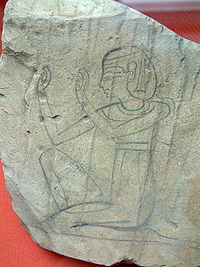.gif)
Man-seated: arms in adoration (hieroglyph)
Encyclopedia
The ancient Egyptian
Man-seated: arms in adoration hieroglyph is one of a series of language
and visual hieroglyph
s used from the earliest dynasties of Ancient Egypt, and that portrays men, women, ideology
, and some occupations.
Used versions of the adoration hieroglyph are with men, women, and groups of individuals; also the adoration-type hieroglyph is shown in a standing pose, with upraised arms. The men and wormen hieroglyphs of both the men and women series, encompass a majority of the human traits, forms, emotions, etc.
, the Libation-priest is used throughout, (beginning at the early lines of the first half-of the Decree of Memphis (Ptolemy V), the named Nubayrah Stele
). One use on the Rosetta Stone 2nd half, of the Libationer-priest is the plural of the priests. The last part of the Decree of Memphis, Ptolemy V-(Rosetta Stone), is to honor Pharaoh Ptolemy by enacting ten items. In the next-to-last line, line R-13, one enactment is:

An example of a single scene is shown on the pictured ostracon
.
Ancient Egypt
Ancient Egypt was an ancient civilization of Northeastern Africa, concentrated along the lower reaches of the Nile River in what is now the modern country of Egypt. Egyptian civilization coalesced around 3150 BC with the political unification of Upper and Lower Egypt under the first pharaoh...
Man-seated: arms in adoration hieroglyph is one of a series of language
Egyptian language
Egyptian is the oldest known indigenous language of Egypt and a branch of the Afroasiatic language family. Written records of the Egyptian language have been dated from about 3400 BC, making it one of the oldest recorded languages known. Egyptian was spoken until the late 17th century AD in the...
and visual hieroglyph
Egyptian hieroglyphs
Egyptian hieroglyphs were a formal writing system used by the ancient Egyptians that combined logographic and alphabetic elements. Egyptians used cursive hieroglyphs for religious literature on papyrus and wood...
s used from the earliest dynasties of Ancient Egypt, and that portrays men, women, ideology
Ideology
An ideology is a set of ideas that constitutes one's goals, expectations, and actions. An ideology can be thought of as a comprehensive vision, as a way of looking at things , as in common sense and several philosophical tendencies , or a set of ideas proposed by the dominant class of a society to...
, and some occupations.
Used versions of the adoration hieroglyph are with men, women, and groups of individuals; also the adoration-type hieroglyph is shown in a standing pose, with upraised arms. The men and wormen hieroglyphs of both the men and women series, encompass a majority of the human traits, forms, emotions, etc.
Use in priest-labationer hieroglyph
A major use of the "seated-adoration" hieroglyph would be as part of the Libationer-Priest (hieroglyph). Although the main man-seated, adoration hieroglyph is not used in the Rosetta StoneRosetta Stone
The Rosetta Stone is an ancient Egyptian granodiorite stele inscribed with a decree issued at Memphis in 196 BC on behalf of King Ptolemy V. The decree appears in three scripts: the upper text is Ancient Egyptian hieroglyphs, the middle portion Demotic script, and the lowest Ancient Greek...
, the Libation-priest is used throughout, (beginning at the early lines of the first half-of the Decree of Memphis (Ptolemy V), the named Nubayrah Stele
Nubayrah Stele
The Nubayrah Stele is a mutilated copy of the Decree of Memphis on a limestone stele; the same decree is found upon the Rosetta Stone...
). One use on the Rosetta Stone 2nd half, of the Libationer-priest is the plural of the priests. The last part of the Decree of Memphis, Ptolemy V-(Rosetta Stone), is to honor Pharaoh Ptolemy by enacting ten items. In the next-to-last line, line R-13, one enactment is:
- "The priests-(Libationer hieroglyphs), of the temples in temple every by its name, shall be called "priest of the god appearing-(epiphanousEpiphany (feeling)An epiphany is the sudden realization or comprehension of the essence or meaning of something...
), lord of benefits," -{Greek: eucharistos), in addition to the ranks of priests of them-(in addition to their other priestly titles). Let write them it upon documents theirs, ...."
Example usage: an ostracon

An example of a single scene is shown on the pictured ostracon
Ostracon
An ostracon is a piece of pottery , usually broken off from a vase or other earthenware vessel. In archaeology, ostraca may contain scratched-in words or other forms of writing which may give clues as to the time when the piece was in use...
.
See also
- Gardiner's Sign List#A. Man and his Occupations

